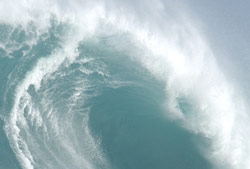
New Tool May Help Minimize Tsunami Death Toll

People in the path of tsunamis may get a few more precious minutes of warning time, thanks to a newly developed tool.
The system looks at the earthquakes on the seafloor that cause the massive and often deadly waves.
"Using this system, we could in the future warn local populations, thus minimizing the death toll from tsunamis," said Andrew Newman of Georgia Tech’s School of Earth and Atmospheric Science.
According to the scientists who developed it, the system, known as RTerg, could help predict the approach of tsunamis and reduce the death toll by giving local residents valuable time to move to safer ground.
The researchers behind RTerg say they used its algorithms to identify an October 2010 earthquake in the Indian Ocean as a rare and destructive "tsunami earthquake." The 7.8 magnitude quake generated waves up to 56 feet (17 meters) high, and killed as many as 430 people on the Indonesian island of Sumatra.
Here's how the new system works. Usually within four minutes, RTerg gets a notification from one of the tsunami warning centers around the Pacific region that an earthquake has occurred. This notice gives the system the quake's location, depth and approximate magnitude.
If the earthquake is determined to be of magnitude 6.5 or higher, it takes about a minute to request and receive data from around 150 seismic stations around the world. Once the system collects these data, it uses its algorithm to run through every second of the rupture and determine the incremental growth of energy and ascertain whether the quake was a tsunami earthquake.
Sign up for the Live Science daily newsletter now
Get the world’s most fascinating discoveries delivered straight to your inbox.
The Sumatran event was the first tsunami quake that occurred when RTerg was online in real time. With that quake, the system identified the event as a potential tsunami earthquake after 8.5 minutes, and sent a notification out shortly thereafter.
"For most tsunami earthquakes, inundation of the coastal environment doesn't occur until about 30 to 40 minutes after the quake. So we'll have about 20 to 30 minutes to get our information to an automatic warning system, or to the authorities," Newman said. "This gives us a tangible amount of time to get people out of the way."
Currently, Newman and his team are working to test and implement a technique for RTerg that could shave another minute or more from the warning time. In addition, they are planning to rewrite the algorithm so that it can be used at all U.S. and international warning centers.
The study appears in the March 5 edition of the journal Geophysical Research Letters.
This article was provided by OurAmazingPlanet, a sister site to LiveScience.










